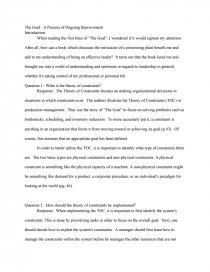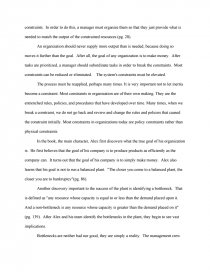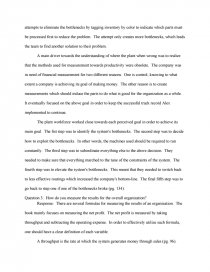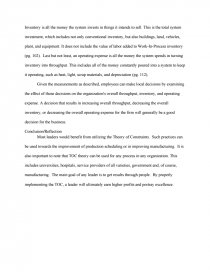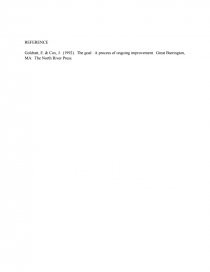The Goal: A Process Of Ongoing Improvement
Essay by 24 • November 7, 2010 • 1,270 Words (6 Pages) • 2,180 Views
The Goal: A Process of Ongoing Improvement
Introduction
When reading the first lines of "The Goal", I wondered if it would capture my attention. After all, how can a book which discusses the intricacies of a processing plant benefit me and add to my understanding of being an effective leader? It turns out that the book lured me and brought me into a world of understanding and optimism in regards to leadership in general, whether it's taking control of my professional or personal life.
Question 1: What is the theory of constraints?
Response: The Theory of Constraints focuses on making organizational decisions in situations in which constraints exist. The authors illustrate the Theory of Constraints (TOC) in production management. They use the story of "The Goal" to focus on solving problems such as bottlenecks, scheduling, and inventory reduction. To more accurately put it, a constraint is anything in an organization that limits it from moving toward or achieving its goal (p.43). Of course, this assumes that an appropriate goal has been defined.
In order to better utilize the TOC, it is important to identify what type of constraints there are. The two basic types are physical constraints and non-physical constraints. A physical constraint is something like the physical capacity of a machine. A non-physical constraint might be something like demand for a product, a corporate procedure, or an individual's paradigm for looking at the world (pg. 46).
Question 2: How should the theory of constraints be implemented?
Response: When implementing the TOC, it is important to first identify the system's constraints. This is done by prioritizing tasks in order to focus on the overall goal. Next, one should decide how to exploit the system's constraints. A manager should first learn how to manage the constraints within the system before he manages the other resources that are not constraints. In order to do this, a manager must organize them so that they just provide what is needed to match the output of the constrained resources (pg. 28).
An organization should never supply more output than is needed, because doing so moves it further than the goal. After all, the goal of any organization is to make money. After tasks are prioritized, a manager should subordinate tasks in order to break the constraints. Most constraints can be reduced or eliminated. The system's constraints must be elevated.
The process must be reapplied, perhaps many times. It is very important not to let inertia become a constraint. Most constraints in organization are of their own making. They are the entrenched rules, policies, and procedures that have developed over time. Many times, when we break a constraint, we do not go back and review and change the rules and policies that caused the constraint initially. Most constraints in organizations today are policy constraints rather than physical constraints.
In the book, the main character, Alex first discovers what the true goal of his organization is. He first believes that the goal of his company is to produce products as efficiently as the company can. It turns out that the goal of his company is to simply make money. Alex also learns that his goal is not to run a balanced plant. "The closer you come to a balanced plant, the closer you are to bankruptcy"(pg. 86).
Another discovery important to the success of the plant is identifying a bottleneck. That is defined as "any resource whose capacity is equal to or less than the demand placed upon it. And a non-bottleneck is any resource whose capacity is greater than the demand placed on it" (pg. 139). After Alex and his team identify the bottlenecks in the plant, they begin to see vast implications.
Bottlenecks are neither bad nor good, they are simply a reality. The management crew attempts to eliminate the bottlenecks by tagging inventory by color to indicate which parts must be processed first to reduce the problem. The attempt only creates more bottlenecks, which leads the team to find another solution to their problem.
A main driver towards the understanding of where the plant when wrong was to realize that the methods used for measurement towards productivity were obsolete. The company was in need of financial measurement for two different reasons. One is control; knowing to what extent a company is achieving its goal of making money. The other reason is to create measurements which should induce the parts to do what is good for the organization as a while. It eventually focused on the above goal in order to keep the successful track record Alex implemented to continue.
...
...
